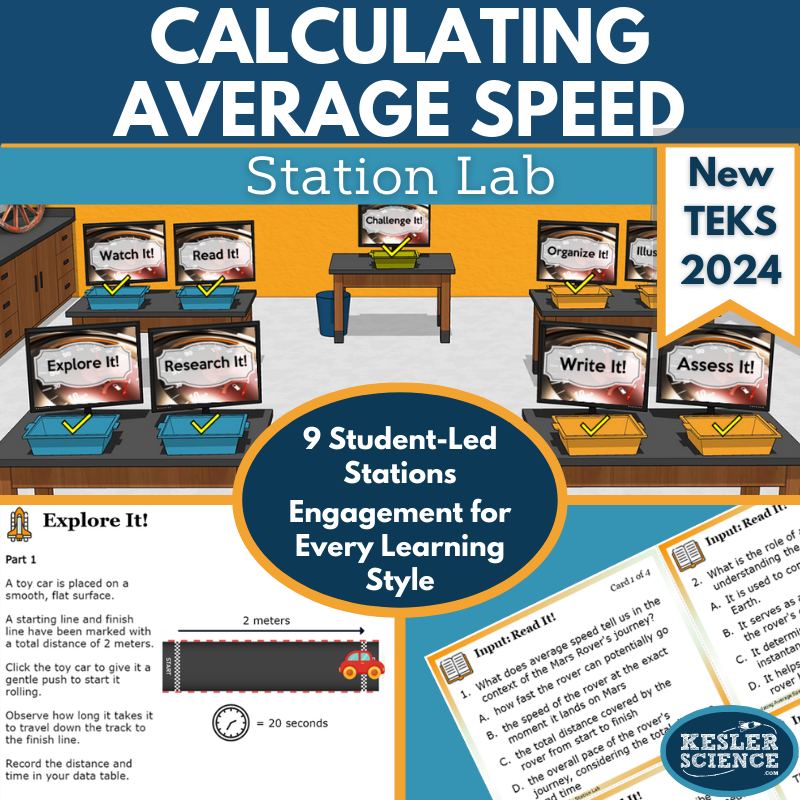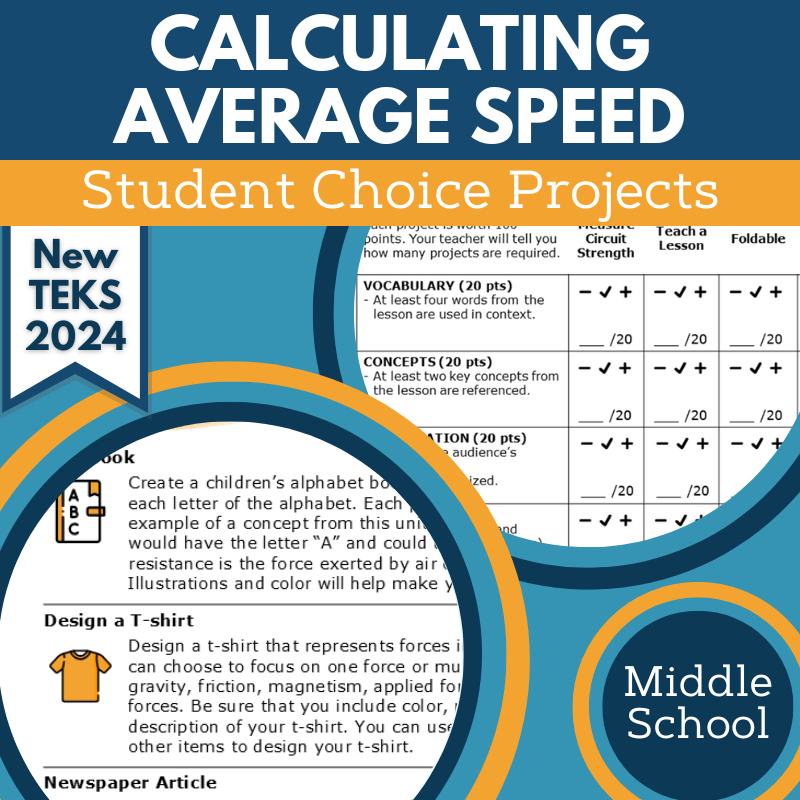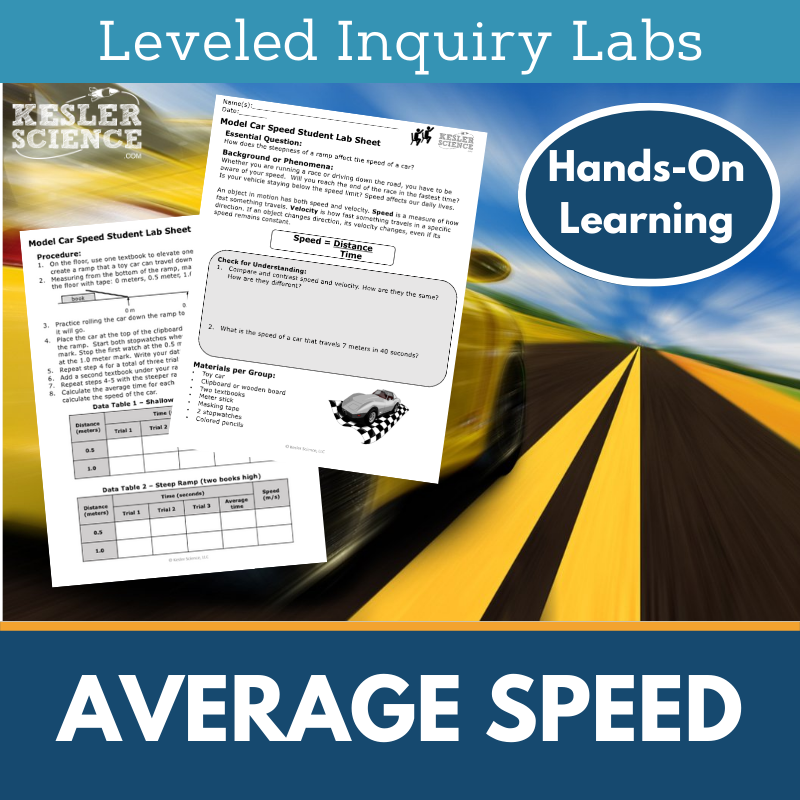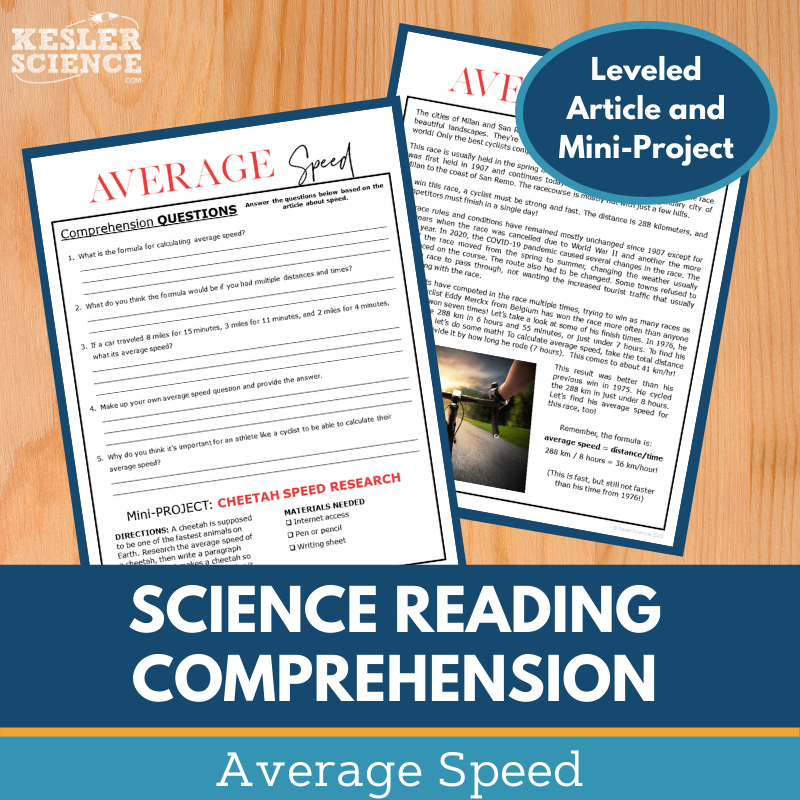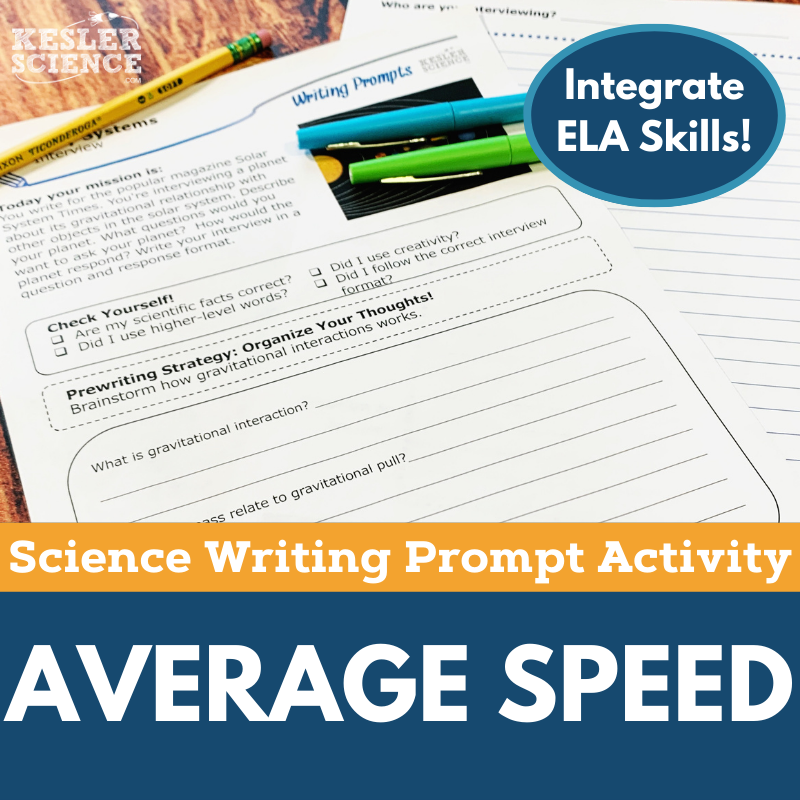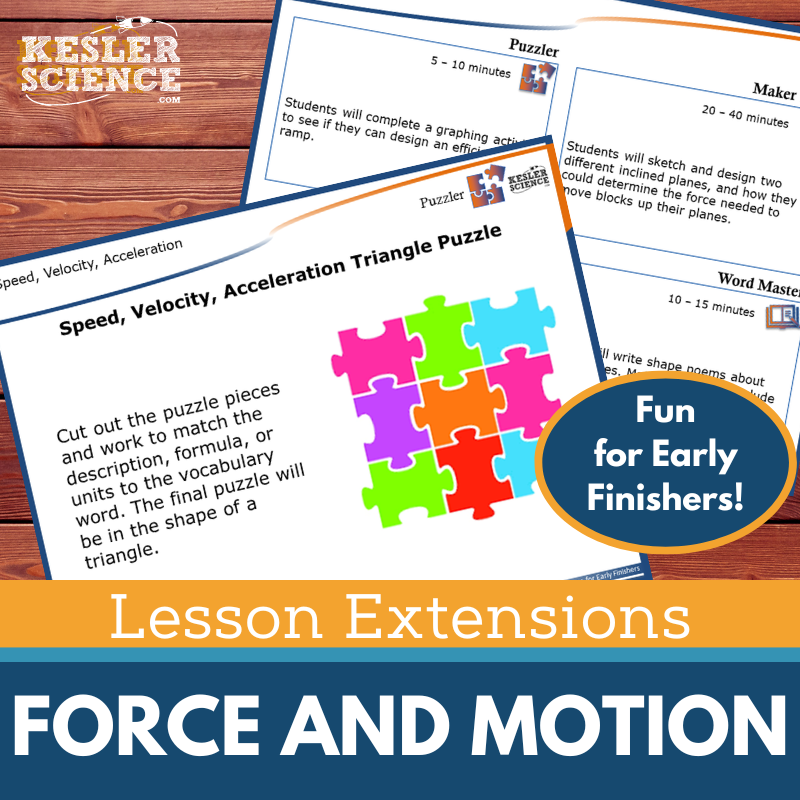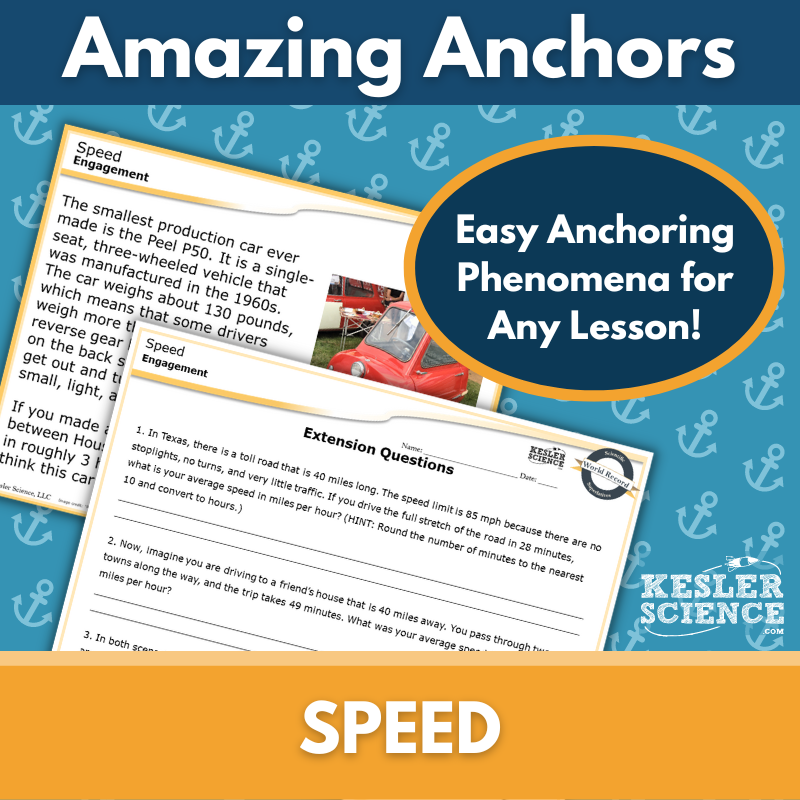Calculating Average Speed Activities for Middle School Science
This engaging 5E lesson helps middle school students master calculating average speed using distance and time measurements. The resources below will give students a comprehensive understanding of average speed. All of the following materials are also included in the Kesler Science Membership.
The Kesler Science Calculating Average Speed 5E Lesson is a comprehensive middle school unit focused on calculating average speed using distance and time measurements from investigations. It includes editable presentations, worksheets, assessments, and student-choice projects, all designed for differentiated, student-led learning. With low to no prep, the lesson is flexible for in-class or virtual learning and aligns with the 2021 TEKS 7.7A standard.
Following the 5E Model, students engage through class discussions and activities. The exploration phase features a hands-on, student-led station lab with nine differentiated stations incorporating reading passages, experiments, videos, research, and interactive categorization tasks. Explanation includes editable PowerPoints, interactive notebooks in English and Spanish, and note-taking templates. For elaboration, students extend their learning through choice projects on total distance and time. Evaluation includes STAAR 2.0-aligned assessments, review questions, and worksheets for test prep or homework.
Multimodal learning, Spanish translations, and maximum format flexibility ensure accessibility for all students. The lesson is fully adaptable, providing everything needed to build a strong foundation in calculating average speed.
The Kesler Science Calculating Average Speed 5E Lesson is a comprehensive middle school unit focused on calculating average speed using distance and time measurements from investigations. It includes editable presentations, worksheets, assessments, and student-choice projects, all designed for differentiated, student-led learning. With low to no prep, the lesson is flexible for in-class or virtual learning and aligns with the 2021 TEKS 7.7A standard.
Following the 5E Model, students engage through class discussions and activities. The exploration phase features a hands-on, student-led station lab with nine differentiated stations incorporating reading passages, experiments, videos, research, and interactive categorization tasks. Explanation includes editable PowerPoints, interactive notebooks in English and Spanish, and note-taking templates. For elaboration, students extend their learning through choice projects on total distance and time. Evaluation includes STAAR 2.0-aligned assessments, review questions, and worksheets for test prep or homework.
Multimodal learning, Spanish translations, and maximum format flexibility ensure accessibility for all students. The lesson is fully adaptable, providing everything needed to build a strong foundation in calculating average speed.
Engage your students with this student-led station lab aligned to TEKS 7.7A, where they calculate average speed using distance and time measurements from investigations. Designed for in-class or virtual learning, this hands-on activity encourages independent exploration and critical thinking.
Students engage with nine differentiated stations that provide multimodal learning experiences. Input stations introduce concepts through experiments, videos, readings, and research, while output stations reinforce learning through organizing, illustrating, writing, and assessment activities. A bonus challenge station offers extension activities like crosswords, games, and mini projects for deeper engagement.
This comprehensive, low-prep resource fosters an interactive and personalized learning environment.
Engage your students with this student-led station lab aligned to TEKS 7.7A, where they calculate average speed using distance and time measurements from investigations. Designed for in-class or virtual learning, this hands-on activity encourages independent exploration and critical thinking.
Students engage with nine differentiated stations that provide multimodal learning experiences. Input stations introduce concepts through experiments, videos, readings, and research, while output stations reinforce learning through organizing, illustrating, writing, and assessment activities. A bonus challenge station offers extension activities like crosswords, games, and mini projects for deeper engagement.
This comprehensive, low-prep resource fosters an interactive and personalized learning environment.
The Calculating Average Speed Student Choice Projects align with the 2021 TEKS standard 7.7A, allowing middle school students to select a project that suits their preferred output style. A project page outlines six student-led options plus a “design your own” project, all supported by an editable rubric for teacher, peer, or self-assessment. This resource is also included in the Calculating Average Speed Complete Lesson for TEKS 7.7A.
These flexible, multimodal projects provide students with creative ways to demonstrate their understanding. Two versions of the project page support differentiation, with modified options for students needing remediation and challenge options for advanced learners. Teachers can customize the rubric to fit grading needs.
The projects use standard classroom supplies like paper, markers, and scissors, and many options are available for digital completion.
The Calculating Average Speed Student Choice Projects align with the 2021 TEKS standard 7.7A, allowing middle school students to select a project that suits their preferred output style. A project page outlines six student-led options plus a “design your own” project, all supported by an editable rubric for teacher, peer, or self-assessment. This resource is also included in the Calculating Average Speed Complete Lesson for TEKS 7.7A.
These flexible, multimodal projects provide students with creative ways to demonstrate their understanding. Two versions of the project page support differentiation, with modified options for students needing remediation and challenge options for advanced learners. Teachers can customize the rubric to fit grading needs.
The projects use standard classroom supplies like paper, markers, and scissors, and many options are available for digital completion.
The Marshmallow Cannon Inquiry Lab aligns with TEKS, helping students calculate speed and average speed using distance and time measurements. This resource includes three differentiated labs to support all learners.
The labs are designed to accommodate different learning needs, including a dependent version with guided inquiry questions, a modified version with structured support and sentence stems, and an independent version where students take full responsibility for the investigation. Editable pages allow for customization, and CER conclusion and reflection questions help students develop claim, evidence, and reasoning statements. Teacher resource pages provide prep instructions, objectives, and materials, while answer keys assist with grading.
Using simple materials like marshmallows, a paper towel roll, masking tape, and a tape measure, students engage in a hands-on activity to explore speed calculations in an interactive and meaningful way.
The Marshmallow Cannon Inquiry Lab aligns with TEKS, helping students calculate speed and average speed using distance and time measurements. This resource includes three differentiated labs to support all learners.
The labs are designed to accommodate different learning needs, including a dependent version with guided inquiry questions, a modified version with structured support and sentence stems, and an independent version where students take full responsibility for the investigation. Editable pages allow for customization, and CER conclusion and reflection questions help students develop claim, evidence, and reasoning statements. Teacher resource pages provide prep instructions, objectives, and materials, while answer keys assist with grading.
Using simple materials like marshmallows, a paper towel roll, masking tape, and a tape measure, students engage in a hands-on activity to explore speed calculations in an interactive and meaningful way.
The Average Speed Science Reading Comprehension Lesson helps students learn to calculate average speed using distance and time measurements through a nonfiction article, comprehension questions, and a mini-project on what makes a cheetah so fast. Designed for grades 6-8, with higher-level 5th graders in mind, the leveled passage supports science literacy and reading comprehension.
The resource includes two Lexile-leveled articles (1100-1300), five to seven comprehension questions, a hands-on mini-project, and a Cornell notes template. The engaging graphics can be printed in grayscale, and the materials are suitable for both in-person and virtual learning environments, including Google Classroom, MS Teams, Schoology, and Canvas.
Ideal for sub plans, extra credit, ISS, or whole-class instruction, this resource fosters critical thinking, classroom discussions, and textual analysis while reinforcing key concepts of average speed.
The Average Speed Science Reading Comprehension Lesson helps students learn to calculate average speed using distance and time measurements through a nonfiction article, comprehension questions, and a mini-project on what makes a cheetah so fast. Designed for grades 6-8, with higher-level 5th graders in mind, the leveled passage supports science literacy and reading comprehension.
The resource includes two Lexile-leveled articles (1100-1300), five to seven comprehension questions, a hands-on mini-project, and a Cornell notes template. The engaging graphics can be printed in grayscale, and the materials are suitable for both in-person and virtual learning environments, including Google Classroom, MS Teams, Schoology, and Canvas.
Ideal for sub plans, extra credit, ISS, or whole-class instruction, this resource fosters critical thinking, classroom discussions, and textual analysis while reinforcing key concepts of average speed.
The Average Speed Science Writing Prompt Activity engages middle school students in a creative journal-based exercise to reinforce their understanding of physical science. Aligned with TEKS, this activity helps students calculate average speed using distance and time measurements while enhancing their science reasoning and writing skills. Designed for both in-person and virtual learning, it keeps students engaged inside and outside the classroom.
This low-prep, student-centered resource includes teacher directions with an answer guide, project ideas, and rubrics; projection and print handouts in both full-sized and half-sheet formats with prompts, self-checks, and pre-writing strategies; and a digital interactive PowerPoint version compatible with Google Slides for remote learning.
Ideal for cross-curricular activities, pre-test assessments, student choice projects, early finisher tasks, extra credit, make-up work, differentiation, or TELPAS samples, this writing prompt is a versatile addition to any classroom. It also works well as a bulletin board display or student anthology collection. While designed for review, students should have prior knowledge of the topic or access to research materials.
The Average Speed Science Writing Prompt Activity engages middle school students in a creative journal-based exercise to reinforce their understanding of physical science. Aligned with TEKS, this activity helps students calculate average speed using distance and time measurements while enhancing their science reasoning and writing skills. Designed for both in-person and virtual learning, it keeps students engaged inside and outside the classroom.
This low-prep, student-centered resource includes teacher directions with an answer guide, project ideas, and rubrics; projection and print handouts in both full-sized and half-sheet formats with prompts, self-checks, and pre-writing strategies; and a digital interactive PowerPoint version compatible with Google Slides for remote learning.
Ideal for cross-curricular activities, pre-test assessments, student choice projects, early finisher tasks, extra credit, make-up work, differentiation, or TELPAS samples, this writing prompt is a versatile addition to any classroom. It also works well as a bulletin board display or student anthology collection. While designed for review, students should have prior knowledge of the topic or access to research materials.
The WIKI Tickets© Force and Motion Set provides engaging, flexible formative assessments for 6th-8th grade science. This set includes 14 topics, each with five format options: a full-screen projection version, three print handouts, and a digital interactive version compatible with PowerPoint and Google Slides.
Aligned with NGSS and TEKS standards, these assessments cover key concepts such as calculating speed and unbalanced forces, graphing motion, gravity and mass, inclined planes, Newton’s laws, velocity, and acceleration. Some topics have multiple tickets, ensuring comprehensive coverage of the standards. A table of contents file is included to show alignment.
Designed for both in-person and virtual learning, WIKI Tickets© can be used as exit tickets, bellringers, or quick checks. Students can respond on paper, interact with projected versions, or complete assignments digitally. These colorful, ready-to-use assessments help you gauge student understanding with ease.
The WIKI Tickets© Force and Motion Set provides engaging, flexible formative assessments for 6th-8th grade science. This set includes 14 topics, each with five format options: a full-screen projection version, three print handouts, and a digital interactive version compatible with PowerPoint and Google Slides.
Aligned with NGSS and TEKS standards, these assessments cover key concepts such as calculating speed and unbalanced forces, graphing motion, gravity and mass, inclined planes, Newton’s laws, velocity, and acceleration. Some topics have multiple tickets, ensuring comprehensive coverage of the standards. A table of contents file is included to show alignment.
Designed for both in-person and virtual learning, WIKI Tickets© can be used as exit tickets, bellringers, or quick checks. Students can respond on paper, interact with projected versions, or complete assignments digitally. These colorful, ready-to-use assessments help you gauge student understanding with ease.
Lesson Extensions provide engaging, student-choice activities designed to challenge early finishers and deepen their understanding of force and motion concepts. These activities help fill downtime, reinforce critical thinking, and keep students engaged with rigorous yet enjoyable learning opportunities aligned with NGSS and TEKS standards.
Each extension includes four interactive components: Puzzler for problem-solving, Maker Space for hands-on STEAM activities, Tech Connection for digital demonstrations, and Word Master for creative writing. With teacher directions, answer keys, and both print and projection versions, these extensions are perfect for lesson wrap-ups, enrichment, or independent challenges.
Topics covered include electromagnetic forces, graphing motion, gravity, inclined planes, Newton’s laws, speed, velocity, acceleration, and unbalanced forces. These high-level, supplementary materials ensure students remain engaged while exploring key physics concepts.
Lesson Extensions provide engaging, student-choice activities designed to challenge early finishers and deepen their understanding of force and motion concepts. These activities help fill downtime, reinforce critical thinking, and keep students engaged with rigorous yet enjoyable learning opportunities aligned with NGSS and TEKS standards.
Each extension includes four interactive components: Puzzler for problem-solving, Maker Space for hands-on STEAM activities, Tech Connection for digital demonstrations, and Word Master for creative writing. With teacher directions, answer keys, and both print and projection versions, these extensions are perfect for lesson wrap-ups, enrichment, or independent challenges.
Topics covered include electromagnetic forces, graphing motion, gravity, inclined planes, Newton’s laws, speed, velocity, acceleration, and unbalanced forces. These high-level, supplementary materials ensure students remain engaged while exploring key physics concepts.
This Amazing Anchors Phenomenon Lesson engages students with an anchoring phenomenon on speed, using a surprisingly small car to spark curiosity. The two-part resource includes an introductory reading with comprehension and extension questions to build understanding, followed by an explanatory reading that simplifies the science behind speed with reinforcement questions to deepen learning.
Aligned with TEKS, this no-prep resource includes teacher directions, answer keys, full-page projection slides, and both digital and print formats for easy classroom integration. A modified version provides differentiated support with sentence starters. Designed to complement any science lesson, these readings serve as engaging supplements for in-person or virtual instruction.
This Amazing Anchors Phenomenon Lesson engages students with an anchoring phenomenon on speed, using a surprisingly small car to spark curiosity. The two-part resource includes an introductory reading with comprehension and extension questions to build understanding, followed by an explanatory reading that simplifies the science behind speed with reinforcement questions to deepen learning.
Aligned with TEKS, this no-prep resource includes teacher directions, answer keys, full-page projection slides, and both digital and print formats for easy classroom integration. A modified version provides differentiated support with sentence starters. Designed to complement any science lesson, these readings serve as engaging supplements for in-person or virtual instruction.
Year-Round Resources
These year-round activities will increase your students' understanding of many middle school science topics. All of these activities are also included in the Kesler Science Membership.
Visual Data & Graphing
You're not alone if your students struggle with understanding graphs, charts, and tables. It's a skill that takes an enormous amount of practice. This resource will help students build a strong foundation in analyzing data and creating their own data visualizations.
Bell Ringers and Warm-Ups
These middle school science bell ringers are an excellent way to engage your students as soon as they walk into your classroom. This comprehensive FULL YEAR resource includes everything you need to start off each science class with an interesting warm-up activity.
Review Board Games
Each game board has been carefully designed to keep students engaged. There are 10 different action spaces on each board and dozens of question cards. All of the actions are related to science concepts and keep the students motivated throughout the game.
Each game is ready to play. Simply print out the board and the cards and let the students enjoy reviewing nine different units.
Essential Questions and Standards
Below are the essential questions and standards associated with the lessons and activities included in the atoms unit. This topic is only one of more than 100 middle school science topics included in the Kesler Science Membership.
-
What measurements of distance and time must be recorded in an investigation for average speed?
-
How is average speed calculated using distance and time measurements?
-
TEKS Science - 7.7A Calculating Average Speed
Kesler Science Membership
Imagine never having to search for another middle school science lesson again. The membership gives you access to ALL of the Kesler Science products in one place (Yes, including everything above).
Say goodbye to long hours of lesson prep.



